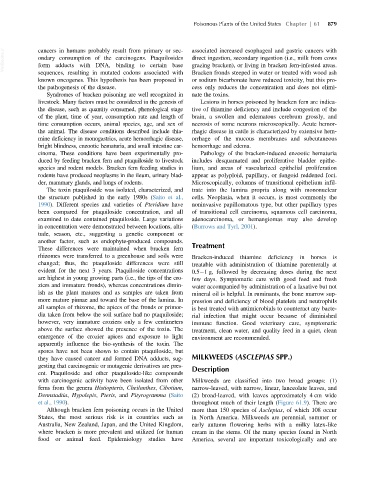Page 925 - Veterinary Toxicology, Basic and Clinical Principles, 3rd Edition
P. 925
Poisonous Plants of the United States Chapter | 61 879
VetBooks.ir cancers in humans probably result from primary or sec- associated increased esophageal and gastric cancers with
direct ingestion, secondary ingestion (i.e., milk from cows
ondary consumption of the carcinogens. Ptaquilosides
grazing bracken), or living in bracken fern-infested areas.
form adducts with DNA, binding to certain base
sequences, resulting in mutated codons associated with Bracken fronds steeped in water or treated with wood ash
known oncogenes. This hypothesis has been proposed in or sodium bicarbonate have reduced toxicity, but this pro-
the pathogenesis of the disease. cess only reduces the concentration and does not elimi-
Syndromes of bracken poisoning are well recognized in nate the toxins.
livestock. Many factors must be considered in the genesis of Lesions in horses poisoned by bracken fern are indica-
the disease, such as quantity consumed, phenological stage tive of thiamine deficiency and include congestion of the
of the plant, time of year, consumption rate and length of brain, a swollen and edematous cerebrum grossly, and
time consumption occurs, animal species, age, and sex of necrosis of some neurons microscopically. Acute hemor-
the animal. The disease conditions described include thia- rhagic disease in cattle is characterized by extensive hem-
mine deficiency in monogastrics, acute hemorrhagic disease, orrhage of the mucous membranes and subcutaneous
bright blindness, enzootic hematuria, and small intestine car- hemorrhage and edema.
cinoma. These conditions have been experimentally pro- Pathology of the bracken-induced enzootic hematuria
ducedbyfeedingbrackenfern and ptaquiloside to livestock includes desquamated and proliferative bladder epithe-
species and rodent models. Bracken fern feeding studies in lium, and areas of vascularized epithelial proliferation
rodents have produced neoplasms in the ileum, urinary blad- appear as polyploid, papillary, or fungoid reddened foci.
der, mammary glands, and lungs of rodents. Microscopically, columns of transitional epithelium infil-
The toxin ptaquiloside was isolated, characterized, and trate into the lamina propria along with mononuclear
the structure published in the early 1980s (Saito et al., cells. Neoplasia, when it occurs, is most commonly the
1990). Different species and varieties of Pteridium have noninvasive papillomatous type, but other papillary types
been compared for ptaquiloside concentration, and all of transitional cell carcinoma, squamous cell carcinoma,
examined to date contained ptaquiloside. Large variations adenocarcinoma, or hemangiomas may also develop
in concentration were demonstrated between locations, alti- (Burrows and Tyrl, 2001).
tude, season, etc., suggesting a genetic component or
another factor, such as endophyte-produced compounds.
Treatment
These differences were maintained when bracken fern
rhizomes were transferred to a greenhouse and soils were Bracken-induced thiamine deficiency in horses is
changed; thus, the ptaquiloside differences were still treatable with administration of thiamine parenterally at
evident for the next 3 years. Ptaquiloside concentrations 0.5 1 g, followed by decreasing doses during the next
are highest in young growing parts (i.e., the tips of the cro- few days. Symptomatic care with good feed and fresh
ziers and immature fronds), whereas concentrations dimin- water accompanied by administration of a laxative but not
ish as the plant matures and as samples are taken from mineral oil is helpful. In ruminants, the bone marrow sup-
more mature pinnae and toward the base of the lamina. In pression and deficiency of blood platelets and neutrophils
all samples of rhizome, the apices of the fronds or primor- is best treated with antimicrobials to counteract any bacte-
dia taken from below the soil surface had no ptaquiloside; rial infection that might occur because of diminished
however, very immature croziers only a few centimeters immune function. Good veterinary care, symptomatic
above the surface showed the presence of the toxin. The treatment, clean water, and quality feed in a quiet, clean
emergence of the crozier apices and exposure to light environment are recommended.
apparently influence the bio-synthesis of the toxin. The
spores have not been shown to contain ptaquiloside, but
they have caused cancer and formed DNA adducts, sug- MILKWEEDS (ASCLEPIAS SPP.)
gesting that carcinogenic or mutagenic derivatives are pres- Description
ent. Ptaquiloside and other ptaquiloside-like compounds
with carcinogenic activity have been isolated from other Milkweeds are classified into two broad groups: (1)
ferns from the genera Histiopteris, Cheilanthes, Cibotium, narrow-leaved, with narrow, linear, lanceolate leaves, and
Dennstadtia, Hypolepis, Pteris,and Pityrogramma (Saito (2) broad-leaved, with leaves approximately 4 cm wide
et al., 1990). throughout much of their length (Figure 61.9). There are
Although bracken fern poisoning occurs in the United more than 150 species of Asclepias, of which 108 occur
States, the most serious risk is in countries such as in North America. Milkweeds are perennial, summer or
Australia, New Zealand, Japan, and the United Kingdom, early autumn flowering herbs with a milky latex-like
where bracken is more prevalent and utilized for human cream in the stems. Of the many species found in North
food or animal feed. Epidemiology studies have America, several are important toxicologically and are

